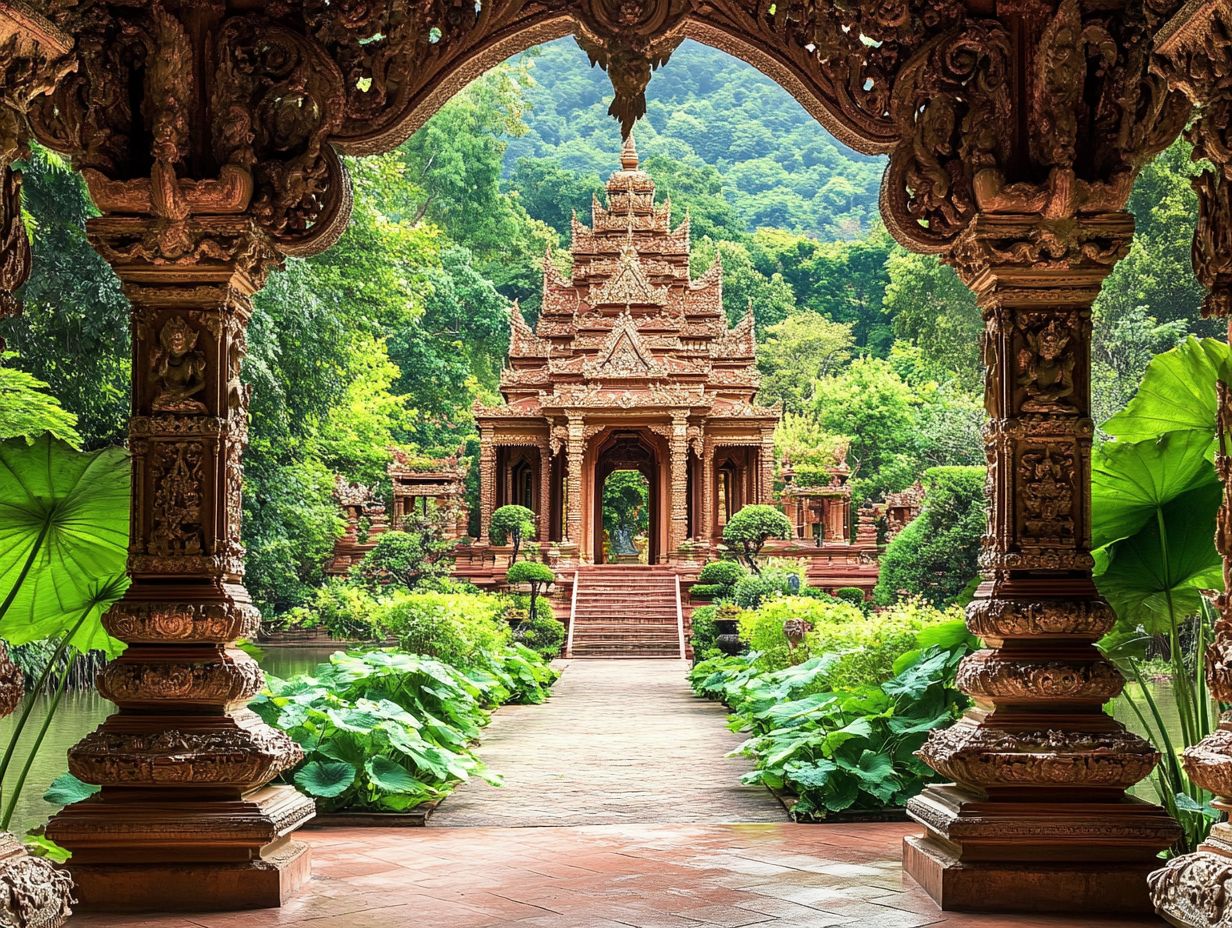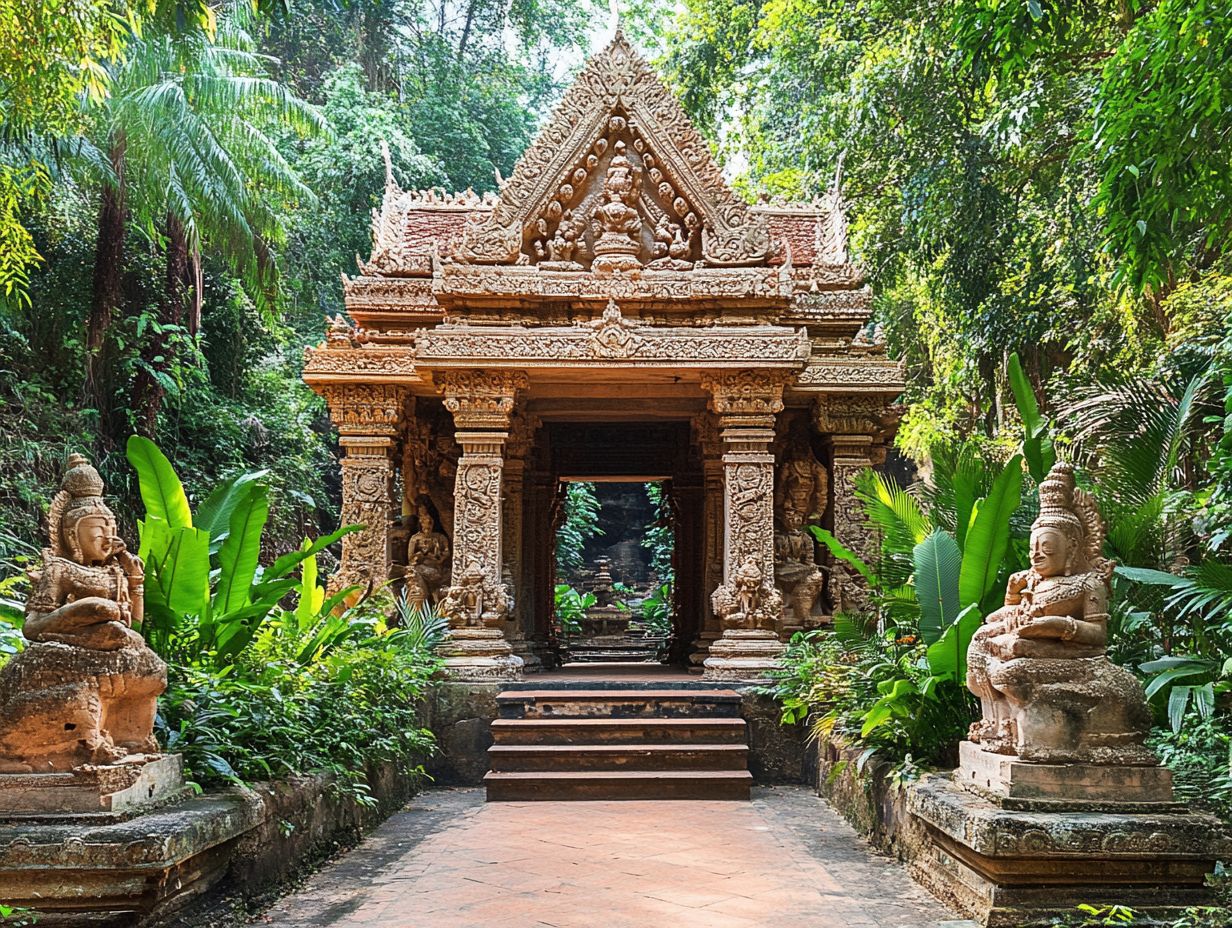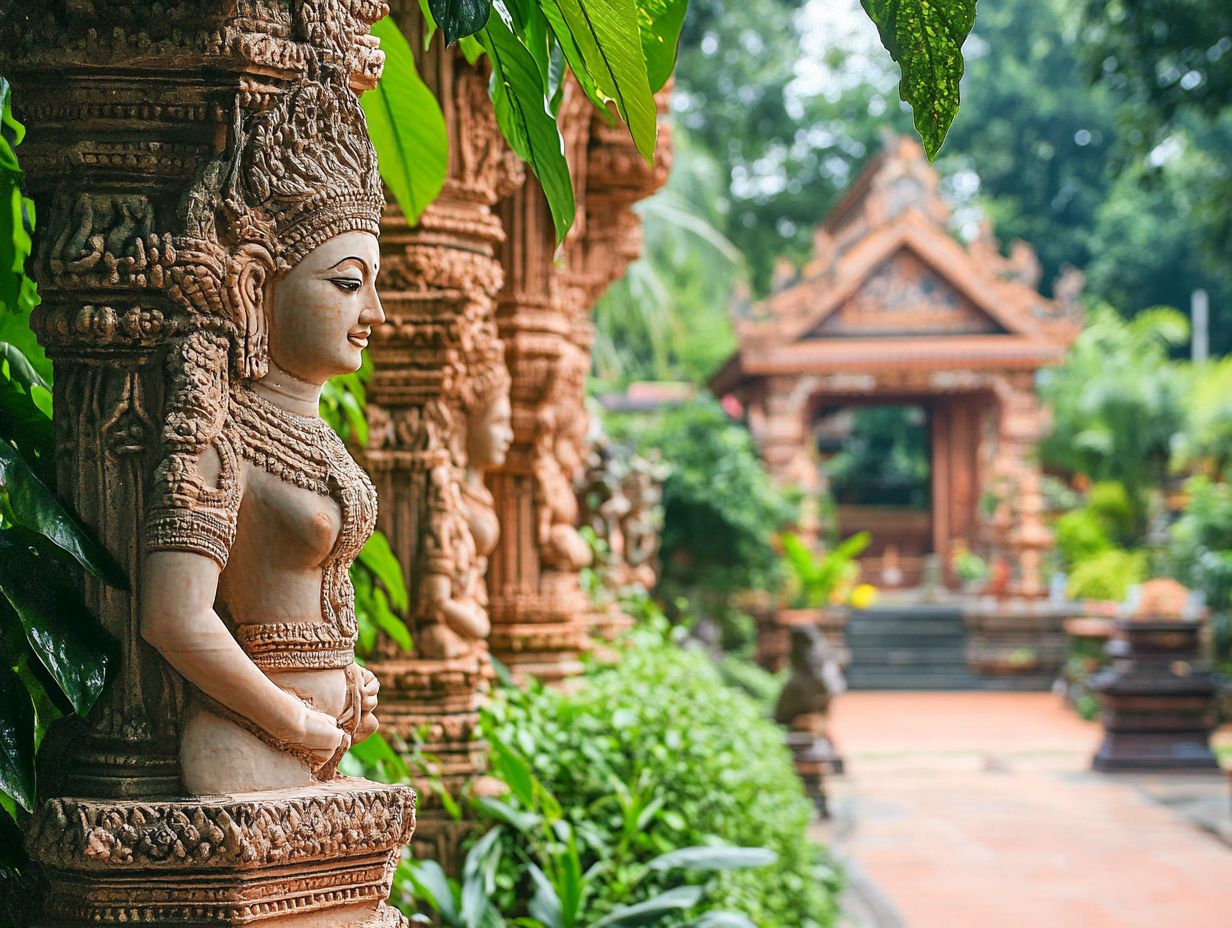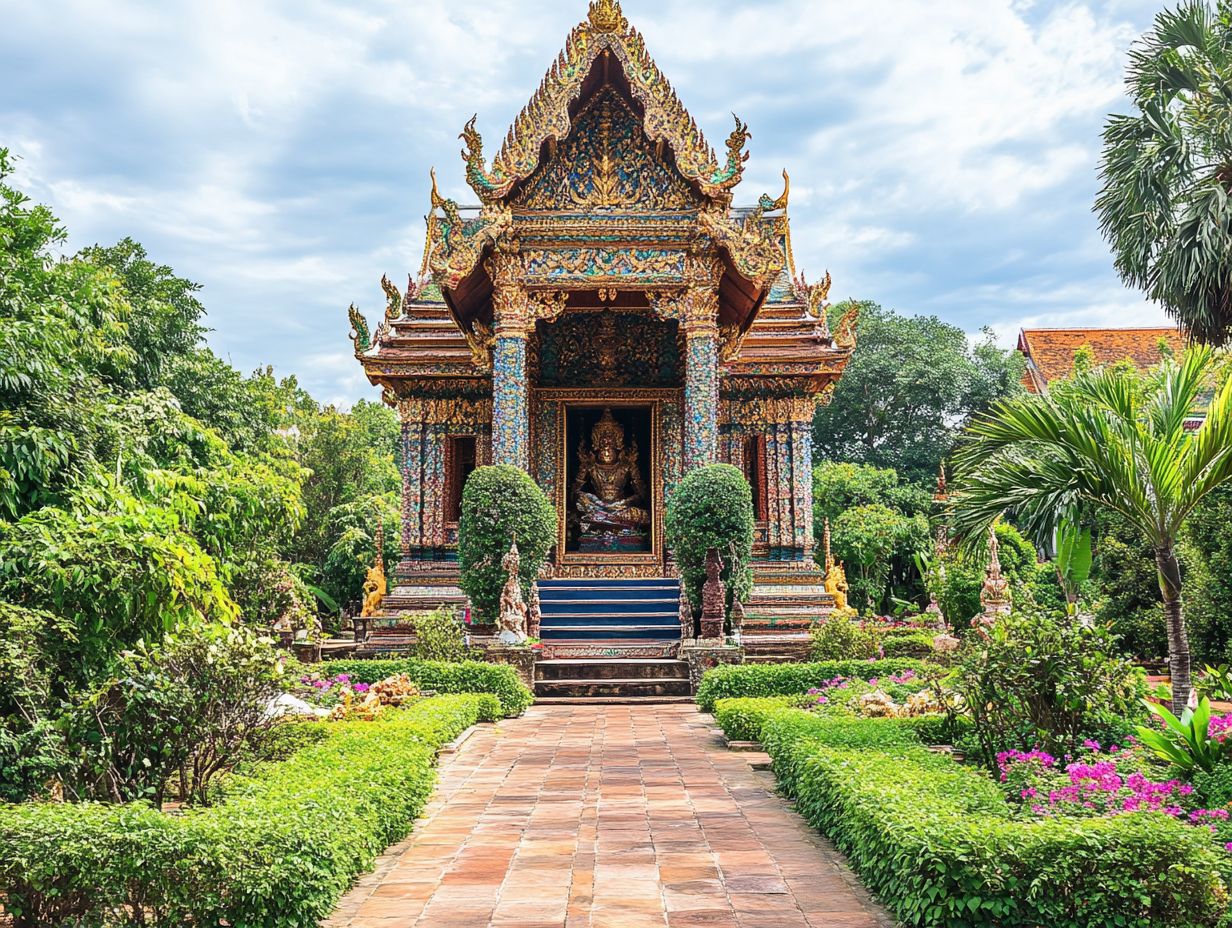Does Thailand Follow Hinduism?
Hinduism, recognized as one of the world’s oldest religions, boasts a captivating history that extends well beyond its origins in India. This exploration delves into the core beliefs of Hinduism and traces its journey to Thailand, primarily through the influence of Indian traders.
The impact of Hinduism on Thai culture is significant, as evidenced by the presence of Hindu temples and the religion’s evolution within the region. Furthermore, this discussion reveals the current state of Hinduism in Thailand and highlights the challenges it faces in the contemporary landscape.
What is Hinduism?

Hinduism stands as one of the world s oldest religions, its roots intricately woven into the spiritual tapestry of Southeast Asia, with Thailand being a notable focal point. This ancient belief system encompasses a rich array of philosophies, rituals, and practices, reflecting a cultural heritage that has been shaped by a multitude of influences, including Brahmanism and animism.
At the heart of Hinduism lie the pivotal concepts of karma and dharma, which serve as guiding principles for the moral compass and spiritual practices of its adherents. Devotees partake in a variety of rituals that honor their deities, such as Vishnu, Shiva, and Ganesha, while drawing upon the teachings encapsulated in revered texts like the Ramayana and Mahabharata.
What are the Core Beliefs of Hinduism?
The core beliefs of Hinduism are intricately woven into fundamental concepts that shape the spiritual and moral framework for its adherents, encompassing karma, dharma, and reincarnation. These principles highlight the significance of ethical living and the cyclical nature of existence, profoundly influencing individual life choices and collective religious practices.
Karma, understood as the law of cause and effect, posits that every action carries moral weight, ultimately determining future circumstances. During the vibrant festival of Diwali, for instance, devotees engage in rituals that symbolize the triumph of good over evil, reinforcing the conviction that virtuous actions attract divine blessings.
Dharma, or one s duty, varies among individuals according to age, caste, and gender, serving as a guide for fulfilling responsibilities with conscientiousness. The rituals surrounding a child’s first haircut, known as mundan, illustrate how families faithfully adhere to their dharmic obligations, invoking protection and auspiciousness for their children.
Reincarnation underscores the journey of the soul, motivating adherents to lead righteous lives, fully aware that their current actions will influence their future incarnations.
How Did Hinduism Spread to Thailand?
The diffusion of Hinduism into Thailand presents a rich tapestry of historical context, cultural exchange, and the profound impact of Indian traders and travelers. This movement did more than merely introduce Hindu religious practices; it cultivated a distinctive syncretism within Thai culture, enabling Hindu beliefs to coexist harmoniously alongside Buddhism and indigenous traditions.
Through ancient trade routes, a myriad of ideas, religions, and cultural symbols traversed vast distances, reshaping Thailand’s spiritual landscape and enhancing its cultural identity.
What Role Did Indian Traders Play in the Spread of Hinduism to Thailand?
Indian traders emerged as instrumental figures in the transmission of Hinduism to Thailand, serving as vital conduits for both trade and the exchange of cultural beliefs and religious practices. Their journeys along maritime trade routes enabled the transfer of ideas, rituals, and sacred texts, leaving a profound and lasting impact on the spiritual practices and societal norms within Thailand.
Through their engagement with local communities, these traders introduced a plethora of elements from Hindu mythology and worship, seamlessly integrating them with existing belief systems. Temples adorned with intricately carved representations of Hindu deities and festivals echoing Hindu traditions gradually became woven into the fabric of Thai culture.
This synthesis not only enriched local traditions but also fostered a distinctive form of spiritual expression that resonated deeply with the Thai populace.
The importance of this cultural exchange transcended mere economic transactions; it cultivated a shared understanding that bridged both geographical and ideological divides, allowing Hinduism to take root and thrive within the rich tapestry of Thailand’s diverse religious landscape.
How Did Hinduism Influence Thai Culture and Traditions?
Hinduism has significantly shaped Thai culture and traditions, contributing to a vibrant tapestry of religious syncretism that characterizes Thailand’s spiritual landscape. This influence manifests in numerous facets of Thai life, from the exuberant celebration of Hindu festivals to the architectural grandeur of temples, where intricate designs and symbolism elegantly intertwine both Hindu and Buddhist aesthetics. Local customs have embraced Hindu deities and myths, enriching the mythology and collective identity of Thai society.
Take the renowned Songkran festival, for instance. Originally grounded in Hindu practices, it features the ritualistic cleansing of Buddha statues and the joyful pouring of water over one another as a means of washing away sins. This tradition beautifully illustrates the fusion of Hindu purification rituals with local customs.
The stunning architecture of Thai temples, exemplified by Wat Arun, showcases elements drawn from Hindu temple designs, including the majestic prang that symbolizes Mount Meru, the axis of the universe in Hindu cosmology.
Furthermore, the myths surrounding Rama from the Ramayana have found their way into Thai literature and dance, demonstrating how these ancient narratives resonate within the cultural fabric of Thailand. This seamless integration of Hindu traditions with local Thai beliefs is a testament to the enduring legacy of Hinduism in shaping the nation’s spiritual and cultural identity.
Is Hinduism the Main Religion in Thailand?

In Thailand, while Hinduism does not dominate the religious landscape, its influence is profoundly felt within the nation’s diverse spiritual demographics, where Buddhism reigns supreme.
Nevertheless, Hindu beliefs and practices exist in a harmonious coexistence with Buddhist traditions, creating a distinctive tapestry of faith that shapes the Thai identity.
The incorporation of Hindu rituals and festivals into Buddhist contexts highlights the rich religious pluralism that is a hallmark of Thai society.
What are the Other Major Religions Practiced in Thailand?
In Thailand, beyond Hinduism, Buddhism exerts a profound influence, embraced by the majority of the population, while Islam and Christianity, among other faiths, also find their place within the country’s spiritual landscape. This remarkable array of religions enhances the cultural diversity of Thailand, weaving a rich social tapestry and nurturing a spirit of religious tolerance among its citizens.
The vibrant mosaic of beliefs not only shapes individual identities but also permeates festivals, art, and the rhythms of daily life across the nation. For instance, the tranquil practices of Buddhism harmoniously blend with the communal celebrations of Islam and the rituals of Christianity, exemplifying a unique coexistence.
Each religious community adds to Thailand’s rich cultural heritage, with awe-inspiring temples and serene mosques adorning the landscape.
This amalgamation of faiths exemplifies a striking level of acceptance and interconnectedness, highlighting how religion, in its numerous forms, plays a crucial role in uniting the Thai populace while simultaneously honoring their diverse traditions.
What Are the Hindu Temples in Thailand?
Hindu temples in Thailand stand as important sacred sites, embodying the rich cultural heritage and spiritual beliefs of the Hindu community. These temples not only display intricate architecture that highlights the influence of Hindu art but also serve as for community worship and religious ceremonies, celebrating the multifaceted nature of devotion within Thai society.
What is the Significance of These Temples in Thai Society?
The significance of Hindu temples in Thai society transcends their architectural allure; they embody a vital element of the religious practices and cultural identity of the communities they serve. These sacred spaces offer avenues for worship, festivals, and communal gatherings, reinforcing the bonds of spirituality and cultural heritage among worshippers.
These temples stand as guardians of tradition, where rituals are meticulously passed down through generations, ensuring the vibrant cultural narratives remain alive. They function not merely as centers for religious observance but also as communal hubs that unite diverse populations, fostering inclusivity and shared values.
The festivals celebrated within these temples resonate deeply with the local community, cultivating a sense of belonging and unity among individuals. Through the vibrant expressions of art, music, and dance that showcase Hindu traditions, these venues play a crucial role in sustaining and enriching the cultural landscape of Thailand.
How Has Hinduism Evolved in Thailand?
The evolution of Hinduism in Thailand embodies a dynamic interplay of cultural integration and adaptation, resulting in a distinctive expression of religious practices that diverges from its Indian origins. Additionally, elements of Brahmanism, deities, and ancient Hindu epics like the Ramayana and Mahabharata have had a profound impact on local practices.
Throughout the centuries, Hinduism has seamlessly assimilated elements from local beliefs and various other religions, culminating in a syncretic faith that not only resonates with Thai identity but also preserves its fundamental Hindu principles.
What are the Differences Between Hinduism in India and Thailand?

The distinctions between Hinduism in India and Thailand reveal themselves through a rich tapestry of cultural practices, religious beliefs, and expressions of spirituality.
While both traditions share foundational principles, the integration of local customs and the profound influence of Buddhism in Thailand have cultivated a unique manifestation of Hinduism that reflects the local ethos, mythology, and societal norms. The influence of Hindu deities such as Shiva, Vishnu, and Brahma is notable in Thai religious festivals and rituals.
The distinctions between Hinduism in India and Thailand reveal themselves through a rich tapestry of cultural practices, religious beliefs, and expressions of spirituality. In Thailand, the influence of Thai mythology and local animism integrates seamlessly with Hindu philosophy and practices.
While both traditions share foundational principles, the integration of local customs and the profound influence of Buddhism in Thailand have cultivated a unique manifestation of Hinduism that reflects the local ethos, mythology, and societal norms.
In India, ritual worship often unfolds in a grand spectacle of elaborate ceremonies, vibrant festivals, and specific deities that vary significantly from one region to another, shaped by historical narratives and local customs. Meanwhile, in Thailand, Hindu influences are intricately woven into the fabric of Buddhist practice, exemplified by the revered figure of Ganesh, who is venerated for his ability to remove obstacles yet finds his place prominently within Buddhist contexts. Additionally, Hindu symbols and iconography have permeated Thai art and architecture.
The annual celebration of festivals like Diwali in India stands in stark contrast to Thailand’s distinctive observances, such as the Loy Krathong festival, which honors both Hindu and Buddhist heritage. Moreover, Thai cultural festivals often incorporate elements of Hindu rituals and ceremonies.
This showcases the remarkable ways in which cultural interpretations of similar traditions can diverge, highlighting the dynamic interplay between religion and local identity in these two vibrant cultures.
What is the Current State of Hinduism in Thailand?
The current landscape of Hinduism in Thailand reveals a small but vibrant community dedicated to preserving its faith within a predominantly Buddhist environment. The influence of Hindu traditions, such as meditation and spiritual practices, continues to be significant.
Despite the deep cultural heritage and historical significance that Hinduism holds in Thailand, this community encounters several challenges. Among these are the efforts to sustain religious traditions in an increasingly modernized society and the quest to enhance its visibility among the wider population.
How Many Hindus are There in Thailand Today?
The Hindu community in Thailand remains relatively small, with estimates indicating a population of approximately 200,000 to 300,000 individuals, primarily concentrated in urban centers like Bangkok. These Hindu communities actively engage in cross-cultural influences and work to preserve their spiritual identity.
Despite its modest size, this community actively preserves its religious customs and engages in cultural activities that sustain Hindu traditions within the wider Thai society.
Though they constitute a minority, the demographic landscape reveals that Hindus can also be found in regions such as Chiang Mai and Phuket, where they contribute to the rich tapestry of local culture. These areas also feature prominent Hindu temples and pilgrimage sites that attract both locals and tourists.
The Hindu community in Thailand is marked by a diverse blend of cultural influences, as many members trace their heritage back to Indian immigrants who arrived over a century ago.
This vibrant legacy is manifested in a variety of festivals, rituals, and culinary traditions practiced within the community, establishing a unique environment where Hindu values and Thai customs coexist harmoniously. The preservation of ancient sacred texts and religious syncretism further enriches their cultural heritage.
Temples and community organizations serve as essential focal points for spiritual gatherings, nurturing a sense of belonging and cultural pride among their members. These Hindu temples are often centers for meditation and spiritual tourism, attracting devotees and scholars alike.
What Challenges Does Hinduism Face in Thailand?
Hinduism in Thailand encounters a multitude of challenges that jeopardize its continuity and visibility, notably the dominant presence of Buddhism and the swift pace of cultural integration and modernization. The presence of other minority religions like Sikhism and Jainism also adds to the religious diversity in Thailand.
These elements threaten to dilute traditional practices and undermine the community’s capacity to sustain its unique identity and heritage amidst a rapidly evolving social landscape.
As the nation increasingly embraces globalization, minority religions such as Hinduism face mounting pressure to conform to mainstream cultural practices, which predominantly favor Buddhist traditions. This environment can result in reduced participation in the festivals and rituals that are integral to Hindu religious life, leading to a growing sense of isolation within the community. Efforts are being made to foster interfaith dialogue and promote multiculturalism to ensure a more inclusive society.
The task of preserving sacred languages and symbols presents another significant challenge, as younger generations may become increasingly detached from their cultural roots. The community is also striving to maintain the relevance of ancient scriptures and traditional ceremonies in contemporary society.
This struggle for cultural integration not only impacts religious observances but also hinders community cohesion, potentially resulting in fragmentation among practitioners striving to balance the demands of modernity with the preservation of their rich heritage.
Frequently Asked Questions
What is the influence of Hinduism on Thai Buddhism?

Hinduism has significantly influenced Thai Buddhism, especially in the areas of mythology, rituals, and religious art. Many Thai Buddhist temples feature Hindu deities, and elements of Hindu philosophy are integrated into Buddhist practices.
What are the major Hindu festivals celebrated in Thailand?
Major Hindu festivals celebrated in Thailand include Diwali, Holi, and Navaratri. These festivals are marked by vibrant rituals and are celebrated with enthusiasm by the Hindu community.
Does Thailand Follow Hinduism?
No, Thailand does not follow Hinduism as its main religion.
Is Hinduism practiced in Thailand?
Hinduism is practiced in Thailand, but it is not the main religion of the country.
What is the main religion of Thailand?
Buddhism is the main religion of Thailand, with over 90% of the population practicing it.
How did Hinduism influence Thailand?
Hinduism has had a significant influence on Thailand’s culture, art, and language, especially during the ancient Khmer Empire. The impact of Hindu cosmology and mythology can be seen in many of Thailand’s historic sites and architectural styles.
Are there any Hindu temples in Thailand?
Yes, there are a few Hindu temples in Thailand, mainly located in Bangkok and other major cities that cater to the small Hindu population in the country. These temples serve as important sacred sites and centers for divine worship and community practices.
Is there a Hindu community in Thailand?
Yes, there is a small Hindu community in Thailand, mostly consisting of Indian immigrants and their descendants. However, it is not a large or significant community in the country.
